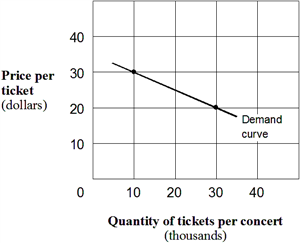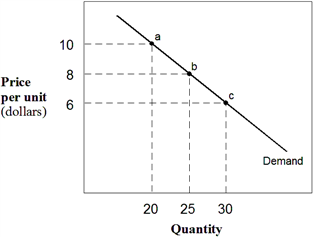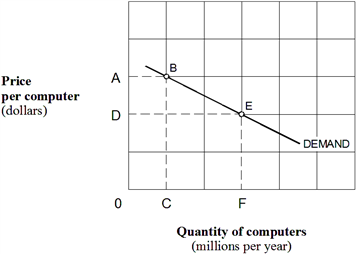A) not be successful if the demand curve slopes downward.
B) be successful if demand is elastic.
C) be successful if demand is inelastic.
D) be successful if supply is elastic.
E) be successful if supply is inelastic.
G) A) and B)
Correct Answer

verified
Correct Answer
verified
Multiple Choice
Over the elastic portion of a demand curve, a decrease in price causes:
A) an increase in total revenue.
B) a decrease in total revenue.
C) no change in total revenue.
D) an increase in quantity demanded, but anything can happen to revenue.
F) All of the above
Correct Answer

verified
Correct Answer
verified
Multiple Choice
A public transit company finds that when it reduces the price of a bus ticket, total revenues remain the same. One can conclude from this that:
A) the demand curve is horizontal, reflecting infinite price elasticity.
B) the company sells the same number of bus tickets both before and after the price change.
C) the demand curve for bus tickets must have shifted to the right.
D) the firm is operating in a range of the demand curve that is unit elastic.
E) the price should be lowered further so that a larger quantity can be sold.
G) A) and D)
Correct Answer

verified
Correct Answer
verified
Multiple Choice
Suppose the president of a college argues that a 25 percent tuition increase will raise revenues for the college. It can be concluded that the president thinks that demand to attend this college is:
A) elastic.
B) inelastic, but not perfectly inelastic.
C) unitary elastic.
D) perfectly elastic.
F) A) and D)
Correct Answer

verified
Correct Answer
verified
Multiple Choice
When demand is price inelastic:
A) price and total revenue move in the same direction.
B) price and total revenue move in the opposite direction.
C) total revenue increases whether price goes up or down.
D) total revenue decreases whether price goes up or down.
F) A) and C)
Correct Answer

verified
Correct Answer
verified
Multiple Choice
If Pete raises his price of muffins from $2 to $3 and his sales revenue increases from $35,000 to $38,000, then:
A) the demand for Pete's muffins in this range is price elastic.
B) the demand for Pete's muffins in this range is price inelastic.
C) the demand for Pete's muffins in this range is unit elastic.
D) the percentage change in quantity demanded must exceed the percentage change in product price.
E) this is impossible since this would violate the law of demand.
G) B) and E)
Correct Answer

verified
Correct Answer
verified
Multiple Choice
If a good has a price elasticity of demand coefficient less than one, then:
A) this good has an elastic demand.
B) this good has an inelastic demand.
C) a 10 percent increase in the price will result in a greater than 10 percent decrease in the quantity demanded.
D) the demand curve will be vertical.
F) A) and C)
Correct Answer

verified
Correct Answer
verified
Multiple Choice
Exhibit 5-6 Demand curve for concert tickets  In Exhibit 5-6, suppose promoters charge a price of $30 per ticket. How much total revenue will their sales generate?
In Exhibit 5-6, suppose promoters charge a price of $30 per ticket. How much total revenue will their sales generate?
A) $300,000.
B) $400,000.
C) $500,000.
D) $600,000.
F) A) and C)
Correct Answer

verified
Correct Answer
verified
Multiple Choice
Price elasticity of demand is defined as the ratio of the:
A) percentage increase in price to an increase in quantity demanded.
B) unit change in quantity demanded to the dollar change in price.
C) maximum amount that consumers will pay to increase quantity.
D) percentage change in quantity demanded to the percentage change in price, other things being equal.
F) A) and D)
Correct Answer

verified
Correct Answer
verified
Multiple Choice
Suppose the Good Food supermarket increases the price of a pound of bananas from $.75 to $1.25 and finds that the quantity of bananas it sells per month drops from 1,500 to 1,000. The price elasticity of demand coefficient for bananas in this price range is:
A) 0.80.
B) 3.00.
C) 2.00.
D) 0.50.
F) B) and D)
Correct Answer

verified
Correct Answer
verified
Multiple Choice
The short-run price elasticity of demand for airline travel is .05, while the long-run elasticity is 2.36. This means that a significant increase in airline ticket prices will cause airline companies to:
A) collect less revenue from short-notice travelers.
B) collect more revenue from travelers who book well in advance.
C) lose money on short-notice travelers.
D) collect less revenue from travelers who book well in advance.
E) lose many of its short-notice travelers.
G) D) and E)
Correct Answer

verified
Correct Answer
verified
Multiple Choice
A _______ demand curve has a price elasticity of demand that is perfectly elastic.
A) vertical
B) rectangular hyperbola
C) horizontal
D) circular
F) A) and B)
Correct Answer

verified
Correct Answer
verified
True/False
Price elasticity remains constant along a straight-line demand curve.
B) False
Correct Answer

verified
Correct Answer
verified
Multiple Choice
If the price elasticity of demand is computed for two products, and product A measures .79, and product B measures 1.6, then:
A) product A is more price elastic than product B.
B) product B is more price elastic than product A.
C) consumers are more sensitive to price changes in product A than in product B.
D) product B is more price inelastic than product A.
E) products A and B must be substitutes.
G) C) and E)
Correct Answer

verified
Correct Answer
verified
Multiple Choice
Exhibit 5-1 Demand curves  In Exhibit 5-1, the demand curve between points a and b is:
In Exhibit 5-1, the demand curve between points a and b is:
A) price elastic.
B) price inelastic.
C) unit elastic.
D) perfectly elastic.
E) perfectly inelastic.
G) B) and C)
Correct Answer

verified
Correct Answer
verified
Multiple Choice
If demand for a good is price elastic, then the price elasticity will be:
A) equal to one.
B) equal to zero.
C) greater than one.
D) less than one.
E) less than zero.
G) B) and E)
Correct Answer

verified
Correct Answer
verified
Multiple Choice
Along the elastic range of a demand curve, a price change causes:
A) a change in total revenue in the opposite direction.
B) a change in total revenue in the same direction.
C) no change in total revenue.
D) an unpredictable change in the total revenue.
F) All of the above
Correct Answer

verified
Correct Answer
verified
Multiple Choice
Exhibit 5-5 Demand curve for computers  In Exhibit 5-5, if the area OABC equals the area ODEF, the demand curve is:
In Exhibit 5-5, if the area OABC equals the area ODEF, the demand curve is:
A) elastic.
B) inelastic.
C) unitary elastic.
D) nonelastic.
F) B) and D)
Correct Answer

verified
Correct Answer
verified
Multiple Choice
If the demand curve over a certain range is "price elastic," this implies that the:
A) percentage change in the quantity demanded exceeds one.
B) percentage change in the quantity demanded exceeds the percentage change in product price.
C) percentage change in price exceeds the percentage change in quantity demanded.
D) product is non-reactive.
E) product has no good substitute.
G) C) and E)
Correct Answer

verified
Correct Answer
verified
Multiple Choice
If the percentage change in the quantity demanded of a good is greater than the percentage change in price, price elasticity of demand is:
A) elastic.
B) inelastic.
C) perfectly inelastic.
D) perfectly elastic.
F) A) and C)
Correct Answer

verified
Correct Answer
verified
Showing 141 - 160 of 181
Related Exams